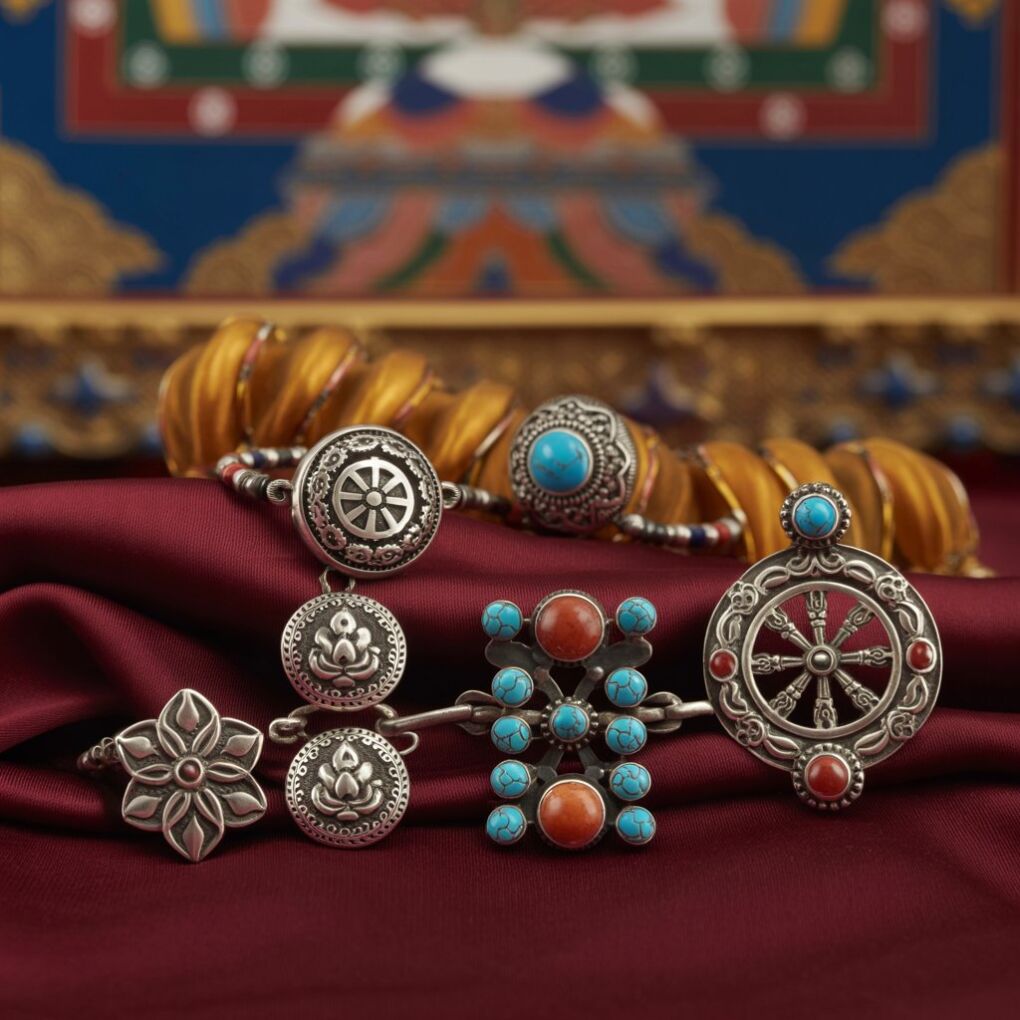Many people today seek jewelry that carries energy and meaning, not just beauty — pieces that feel alive with intention. Thangka-inspired jewelry embodies this perfectly, drawing from Tibetan Buddhist art where every color and symbol holds spiritual purpose. Once used for meditation and enlightenment, these sacred motifs are now crafted into wearable symbols that connect modern wearers to ancient wisdom. In this guide, we’ll uncover what these symbols — from the Lotus of purity to the Vajra of indestructible spirit — truly mean, and why wearing them can be a powerful reminder of mindfulness, protection, and purpose in everyday life.

The Origins of Thangka Art and Its Symbolic Language
Thangka art, a sacred Tibetan Buddhist tradition, began as painted scrolls used for meditation and visualization, each detail symbolizing spiritual truths. Mandalas reflect cosmic order, deities like Avalokiteshvara and Manjushri embody compassion and wisdom, and every color carries meaning—from gold for enlightenment to blue for infinite space. Over time, artisans transformed these symbolic paintings into Thangka-inspired jewelry, crafting pendants and bracelets that preserve their spiritual essence. Wearing these pieces allows one to carry centuries of devotion and mindfulness close to the heart—a living reminder of balance, compassion, and the path toward enlightenment.
Core Spiritual Symbols and Their Meanings
Thangka jewelry carries deep symbolic meaning drawn from Buddhist art. Here’s the breakdown of each key symbol into its origin, meaning, and modern significance in jewelry form. The Lotus Flower represents purity and enlightenment, reminding wearers that clarity can rise even from struggle. The Wheel of Dharma symbolizes the Eightfold Path and mindful action, while the Vajra embodies indestructible strength and spiritual clarity. Mantra inscriptions, like Om Mani Padme Hum, serve as wearable prayers, channeling compassion and protection through sound and intention. Finally, Deity motifs such as Avalokiteshvara and Manjushri connect the wearer to qualities of compassion and wisdom—turning each piece into a sacred reminder of inner balance and awakening.
To see how these meanings come alive in real designs, explore our Top 5 Thangka Jewelry Pieces Every Spiritual Seeker Needs — a curated guide to pieces that embody wisdom, compassion, and protection.
Why These Symbols Still Matter Today
In a world that often feels fast and fragmented, the ancient symbols of Thangka art have found new relevance. As mindful living and spiritual gifting grow in popularity, people seek adornments that carry meaning beyond aesthetics — jewelry that reflects their values, energy, and inner journey. Wearing Thangka-inspired pieces has become a quiet act of mindfulness, a daily reminder to pause, breathe, and stay centered amid the noise. Each symbol — whether a lotus for purity or a mantra for compassion — connects modern wearers to centuries of spiritual intention. In this way, Thangka jewelry bridges the sacred and the contemporary, allowing one’s personal style to also express a deeper sense of purpose and connection.
How to Choose Thangka Jewelry That Resonates with You
Choosing Thangka jewelry is as much a spiritual decision as it is an aesthetic one. Begin by identifying your personal intention — whether you seek compassion, protection, clarity, or inner peace — and let that guide the symbol you choose. A lotus may inspire growth and purity, while a Vajra pendant may strengthen resilience and focus. Beyond symbolism, pay attention to craftsmanship and materials. Authentic Thangka pieces are often hand-painted or consecrated through traditional rituals, preserving the sacred energy they represent. Finally, consider ethical sourcing and authenticity. Jewelry created with mindfulness — from sustainably obtained metals to artisans paid fairly — carries purer energy and truer meaning. When chosen with awareness, a Thangka-inspired pendant or bracelet becomes more than an accessory; it becomes a reflection of your spirit and the values you carry each day.
The Deeper Connection: Jewelry as a Meditation Tool
Thangka jewelry is more than symbolic—it can be a living part of one’s spiritual practice. During meditation or prayer, a Thangka pendant can serve as a physical anchor for focus: gently holding it while breathing deeply helps quiet the mind and connect intention with presence. Many practitioners use their jewelry as a daily ritual, touching the pendant upon waking, visualizing the energy of its symbol, or softly reciting a mantra like Om Mani Padme Hum to cultivate mindfulness throughout the day. For some, this practice transforms an ordinary object into a sacred companion—a steady reminder of compassion, clarity, or courage in motion. Whether during quiet reflection or in the rush of daily life, Thangka jewelry offers a tangible way to carry stillness and spiritual awareness wherever you go.
